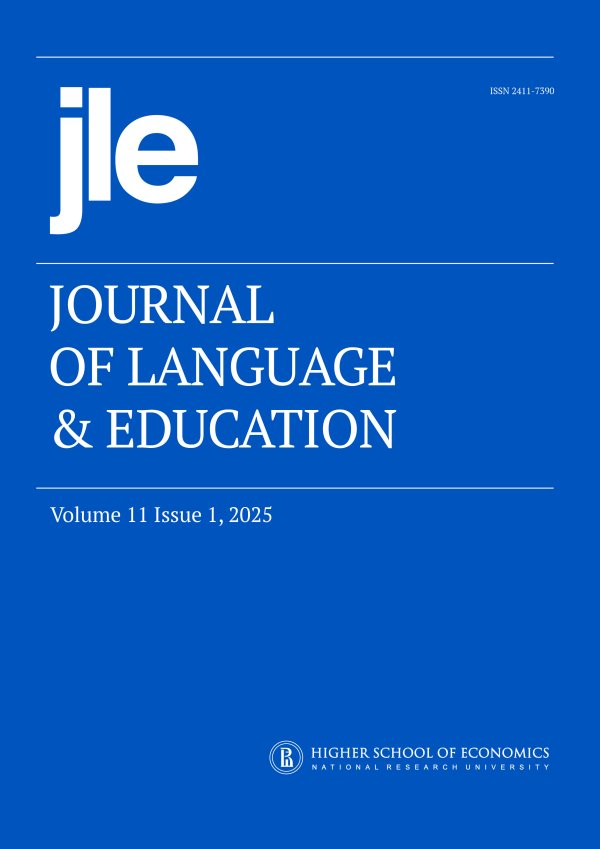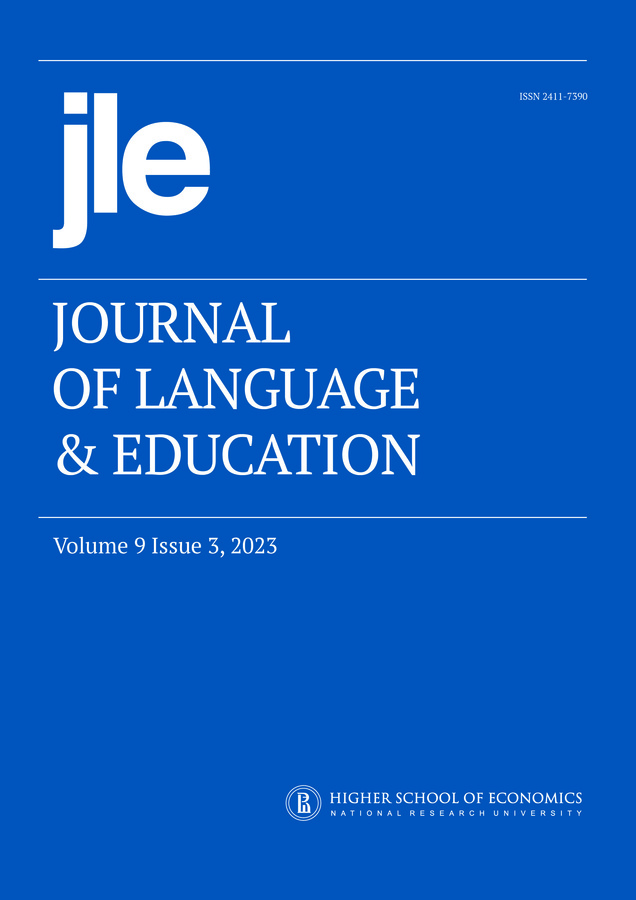A Corpus-based Investigation of Phrasal Complexity Features and Rhetorical Functions in Data Commentary
- Авторы: Parviz M.1, Lan G.2
-
Учреждения:
- Imam Ali University, Tehran, Iran
- City University of Hong Kong, Hong Kong SAR, China
- Выпуск: Том 9, № 3 (2023)
- Страницы: 90-109
- Раздел: Оригинальное исследование
- URL: https://journal-vniispk.ru/2411-7390/article/view/301922
- DOI: https://doi.org/10.17323/jle.2023.16044
- ID: 301922
Цитировать
Полный текст
Аннотация
Introduction: In academic written texts, linguistic and rhetorical features are often interactively used as a vehicle for writers to construct their texts in order to accomplish specific communicative purposes. However, the effective integration of these resources may pose challenges for developing writers.
Purpose: This study employed a corpus-based genre analysis approach to investigate phrasal complexity features and rhetorical functions in data commentaries written by Iranian undergraduate and graduate students. Through this approach, we aimed to examine a relatively unexplored genre of data commentary in terms of its phrasal complexity features, rhetorical functions, and their relationships. By analyzing these relationships, we sought to provide insights into the writing practices of Iranian undergraduate and graduate students in the context of data commentaries.
Method: This study employed a convenient sampling method to select a total of 76 university students, which included 47 undergraduate students and 29 graduate students. The participants were involved in generating a corpus of 380 data commentaries, which were then thoroughly examined and compared. To identify instances of phrasal complexity features, the researchers utilized the AntConc software tool, applying regular expressions (regex) to extract potential occurrences. Additionally, a Python program was developed and implemented to calculate the frequencies of the identified PCFs. The researchers manually annotated the rhetorical function of the data commentaries to determine their specific usage.
Results: Statistical analysis such as Mann Whitney U test and Spearman correlation test, revealed that graduate students significantly utilized more phrasal complexity features including attributive adjectives, nominalizations, and prepositional phrases (of) compared to undergraduate students. However, a qualitative analysis showed that the use of these linguistic features is influenced by the writing topics. Regarding rhetorical functions, graduate students used more moves and/or steps related to presenting and commenting data, while undergraduate students produced more moves or steps concerning personal asides. Moreover, certain phrasal complexity features and the moves and/or steps were found to be correlated, aligning with recent corpus-based studies.
Conclusion: The study concludes with pedagogical implications.
Ключевые слова
Об авторах
M. Parviz
Imam Ali University, Tehran, Iran
Автор, ответственный за переписку.
Email: mohammad.parviz60@gmail.com
G. Lan
City University of Hong Kong, Hong Kong SAR, China
Email: gelan4@cityu.edu.hk
Список литературы
- Ansarifar, A., Shahriari, H., & Pishghadam, R. (2018). Phrasal complexity in academic writing: A comparison of abstracts written by graduate students and expert writers in applied linguistics. Journal of English for Academic Purposes, 31, 58-71. DOI: https://doi.org/10.1016/j.jeap.2017.12.008
- Biber, D. (1988). Variation across speech and writing. Cambridge University Press.
- Biber, D., Connor, U., & Upton, T. (2007). Discourse on the move: Using corpus analysis to describe discourse structure. John Benjamins Publishing.
- Biber, D., & Gray, B. (2010). Challenging stereotypes about academic writing: Complexity, elaboration, explicitness. Journal of English for Academic Purposes, 9(1), 2-20. DOI: https://doi.org/10.1016/j.jeap.2010.01.001
- Biber, D., Gray, B., & Poonpon, K. (2011). Should we use characteristics of conversation to measure grammatical complexity in L2 writing development? TESOL Quarterly, 45(1), 5-35. DOI: https://doi.org/10.5054/tq.2011.244483
- Biber, D., Gray, B., Staples, S., & Egbert, J. (2022). The register-functional approach to grammatical complexity: Theoretical foundation, descriptive research findings, application. Routledge.
- Charles, M. (2007). Reconciling top-down and bottom-up approaches to graduate writing: Using a corpus to teach rhetorical functions. Journal of English for Academic Purposes, 6, 289-302. DOI: https://doi.org/10.1016/j.jeap.2007.09.009
- Cohen, J. (1988). Statistical power analysis for the behavioral sciences. Lawrence Erlbaum Associates, Publishers.
- Cullen, P., French, A., & Jakeman, V. (2014). The official cambridge guide to IELTS for academic and general training. Cambridge University Press.
- Eriksson, A., & Nordrum, L. (2018). Unpacking challenges of data commentary writing in master's thesis projects: an insider perspective from chemical engineering. Research in Science & Technological Education, 36 (4), 499-520. DOI: https://doi.org/10.1080/02635143.2018.1460339
- Hyland, K. (2000). Disciplinary discourses: Social interaction in academic writing. Pearson.
- Hyland, K. (2019). Metadiscourse: Exploring interaction in writing. Continuum.
- Jalilifar, A., Parviz, M., & Don, A. (2019). Exploring phrasal complexity features in graduate students' data commentaries and research articles. Journal of English Language Teaching and Learning, 24(11), 118-152. DOI: https://doi.org/10.22055/.2019.17801
- Jiang, F. K., & Hyland, K. (2015). ‘The fact that': Stance nouns in disciplinary writing. Discourse Studies, 17(5), 529-550. DOI: https://doi.org/10.1177/1461445615590719
- Jiang, F. K., & Hyland, K. (2021). ‘The goal of this analysis …': Changing patterns of metadiscursive nouns in disciplinary writing. Lingua, 252, 103017. DOI: https://doi.org/10.1016/j.lingua.2020.103017
- Lan, G., & Sun, Y. (2019). A corpus-based investigation of noun phrase complexity in the L2 writings of a first-year composition course. Journal of English for Academic Purposes, 38, 14-24. DOI: https://doi.org/10.1016/j.jeap.2018.12.001
- Lavelle, E., & Bushrow, K. (2007). Writing approaches of graduate students. Educational Psychology, 27(6), 807-822. DOI: https://doi.org/10.1080/01443410701366001
- Lim, J. M. H. (2011). Paving the way for research findings: Writers' rhetorical choices in education and applied linguistics. Discourse Studies, 13(6), 725-749. DOI: https://doi.org/10.1177/1461445611421364
- Lu, X., Yoon, J., & Kisselev, O. (2021). Matching phrase-frames to rhetorical moves in social science research article introductions. English for Specific Purposes, 61, 63-83. DOI: https://doi.org/10.1016/j.esp.2020.10.001
- Lu, X., Yoon, J., Kisselev, O., Casal J., Deng, J., & Nie, R. (2021). Rhetorical and phraseological features of research article introductions: Variation among five social science disciplines. System, 100, 102543. DOI: https://doi.org/10.1016/j.system.2021.102543
- Moreno, A. & Swales, J. M. (2018). Strengthening move analysis methodology towards bridging the function-form gap. English for Specific Purposes, 50, 40-63. DOI: https://doi.org/10.1016/j.esp.2017.11.006
- Nordrum, L., & Eriksson., A. (2015). Using a small, specialized corpus for formative self-assessment practices. In M. Callies & S. Götz (Eds.), Learner corpora in language testing and assessment. Studies in corpus linguistics (vol. 70, pp. 59-84). John.
- Benjamins Publishing Company.
- Parkinson, J., & Musgrave, J. (2014). Development of noun phrase complexity in the writing of English for academic purposes students. Journal of English for Academic Purposes, 14, 48-59. DOI: https://doi.org/10.1016/j.jeap.2013.12.001
- Parviz, M. (2023). A comparative corpus-based investigation of results sections of research articles in Applied Linguistics and Physics. ICAME Journal, 47(1). DOI: https://doi.org/10.2478/icame-2023-0005
- Parviz, M., Jalilifar, A., & Don, A. (2020). Phrasal discourse style in cross-disciplinary writing: A comparison of phrasal complexity features in the results sections of research articles. Círculo de Lingüística Aplicada a la Comunicación, 83, 191-204. DOI: https://doi.org/10.5209/clac.70573
- Samraj, B. (2008). A discourse analysis of master's theses across disciplines with a focus on introductions. Journal of English for Academic Purposes, 7, 55-67. DOI: https://doi.org/10.1016/j.jeap.2008.02.005
- Sancho Guinda, C. (2012). Proximal positioning in students' graph commentaries. In K. Hyland & C. Sancho Guinda (Eds.), Stance and Voice in Written Academic Genres (pp.166-183). Palgrave Macmillan.
- Staples, S., Egbert, J., Biber, D., & Gray, B. (2016). Academic writing development at the university level: Phrasal and clausal complexity across level of study, discipline, and genre. Written Communication, 33(2), 149-183. DOI: https://doi.org/10.1177/074108831663152
- Staples, S., & Reppen, R. (2016). Understanding first-year L2 writing: A lexicogrammatical analysis across L1s, genres, and language ratings. Journal of Second Language Writing, 32, 17-35. DOI: https://doi.org/10.1016/j.jslw.2016.02.002
- Swales, J. M. (1990). Genre analysis: English in academic and research settings. Cambridge University Press.
- Swales, J. M. (2004). Research genres: Explorations and applications. Cambridge University Press.
- Swales, J. M. & Feak, C.B. (1997). From information transfer to data commentary. In Miller, T. (Ed.), Functional approaches to written text: Classroom applications. United States Information Agency.
- Swales, J. M., & Feak, C. B. (2012). Academic writing for graduate students: Essential tasks and skills. University of Michigan Press.
- Wharton, S. (2012). Epistemological and interpersonal stance in a data description task: Findings from a discipline-specific learner corpus. English for Specific Purposes, 31(4), 261-270. DOI: https://doi.org/10.1016/j.esp.2012.05.005
- Yang, R., & Allison, D. (2003). Research articles in applied linguistics: Moving from results to conclusions. English for Specific Purposes, 22(4), 365-385. DOI: https://doi.org/10.1016/S0889-4906(02)00026-1
Дополнительные файлы











